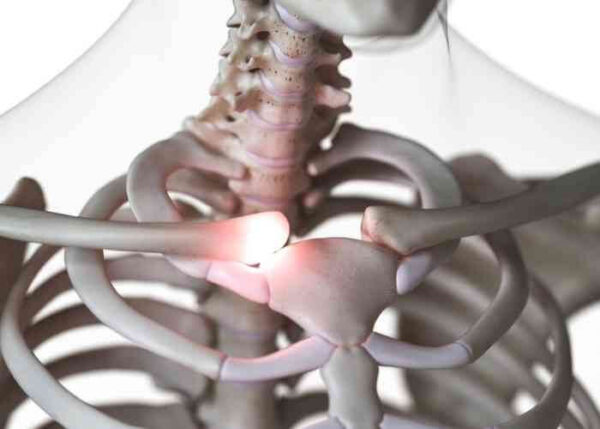SC Joint Injury Specialist

Are you an athlete who participates in contact sports such as hockey or football? If so, you may be at risk of sustaining a sternoclavicular (SC) joint injury. SC Joint injuries are usually caused by a direct blow or blunt trauma to the collarbone area of the shoulder. SC joint injury specialist, Doctor Riley J. Williams provides diagnosis as well as surgical and nonsurgical treatment options for patients in Manhattan, Brooklyn, New York City and surrounding areas who have sustained an SC joint injury. Contact Dr. Williams’ team today!
What is a sternoclavicular joint injury?
A sternoclavicular (SC) joint injury describes an injury to the joint between the medial clavicle and sternum of the rib cage (thorax). SC joint injuries can occur following a motor vehicle accident or impact associated with contact sports (football, rugby). SC joints can also sustain damage if the protective cartilage in the joint wears away over time due to osteoarthritis. The SC joint is one of four joints within the shoulder. It is located at the base of the neck where the clavicle (collar bone) connects to the sternum (breastbone). Although an injury to the SC joint is uncommon, it can be a serious injury. SC joint injuries are typically associated with significant external force to the chest and airways. Important nerves and blood vessels lie behind the sternoclavicular joint, making these types of injuries potentially serious. Dr. Riley J. Williams, orthopedic shoulder specialist serving Manhattan, Brooklyn, New York City, NY and surrounding areas has extensive experience in treating sternoclavicular joint injuries and other shoulder related injuries.

What are the symptoms of an SC joint injury?
Osteoarthritis, and trauma can cause injury to the SC joint. The symptoms associated with an SC joint injury include:
- Pain and tenderness
- Swelling
- Bruising
- Inability to move the arm in a full range of motion
- Redness over the joint site
- Pain in other joints (associated with rheumatoid arthritis)
- Clicking or grinding noise when the arm is moved
How is an SC joint injury diagnosed?
Dr. Williams will discuss your medical history with you before performing a physical examination. He will inquire when the pain began and if it is related to a particular accident or injury. During the physical exam, Dr. Williams will check for range of motion, tenderness, bumps, or deformities over the joint and the blood flow in the hands and fingers. Imaging tests will be ordered to ensure a proper diagnosis. These may include x-rays, CT scans or an MRI.
How is an SC joint injury treated?
Non-surgical treatment:
It is possible for this type of injury to be treated non-surgically if none of the structures withing the joint are damaged. Dr. Williams may recommend activity modifications and immobilizing the joint to give it time to heal. If the injury is caused by osteoarthritis or rheumatoid arthritis, corticosteroid injections can provide relief from pain and inflammation. Non-steroidal anti-inflammatory medications can also help manage pain and swelling. If the SC joint injury was sustained from a dislocation, Dr. Williams may perform a closed reduction under anesthesia to manipulate bones back into their proper place.
Surgical treatment:
If an open reduction is necessary, it is done under anesthesia and requires incisions to reposition bones into their original position. If the injury stems from an infection, Dr. Williams will need to open the joint to drain the infection. Antibiotics are required after the procedure. Surgical procedures to fix the injury from osteoarthritis are rare but can be performed if conservative treatment methods have failed to alleviate pain. Surgery for SC joint condition is rare. Dr. Williams will be sure such procedures are necessary prior to their indication.
For more information on a sternoclavicular joint injury and the treatment options available, please contact the office of Riley J. Williams, MD, orthopedic shoulder specialist serving Manhattan, Brooklyn, New York City, NY and surrounding areas.